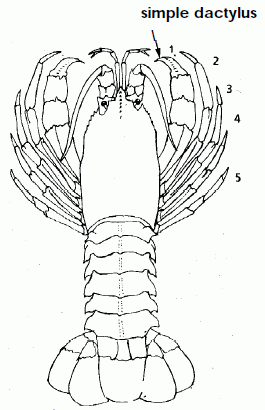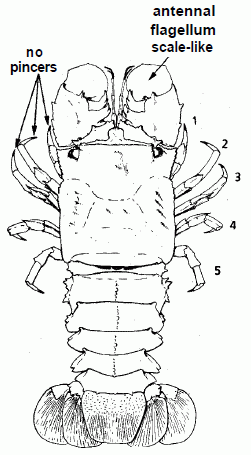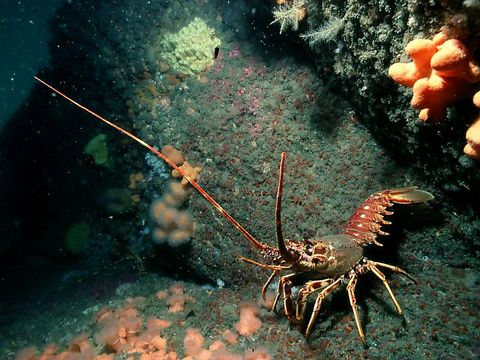Decapoda: Palinuroidea
Taxa on This Page
- Palinuroidea
- Palinuridae
- Scyllaridae
The Palinuroidea are a small but unique group of decapods that include such evocatively named forms as spiny lobsters, slipper lobsters, and furry lobsters, as well as several fossil lineages.
Exactly where they belong is a mystery. According to some morphological cladistic (Scholtz & Richter 1995) and molecular and morphology (e.g. Ahyong & O'Meally 2004) analyses occupy a fairly basal position, whereas according to other cladistic (Dixon et al 2003) and molecular (e.g. Porter et al 2005, Bracken et al 2009) analyses are more related to crabs, or anywhere in between. Since no one seems to agree where they should belong (which is nothing new in the world of decapod phylogeny, we have left them in the middle for now. Should decapod phylogenetic studies ever reach any sort of consenus (which seems unlikely in the forseeable future) these pages can be adjusted accordingly.
Palinura or Achelata?
It has been argued that it is incorreect to use Palinura, as that name that more properly pertains to a paraphyletic or polyphyletic assemblage of lobster-like forms. An alternative name is Achelata (Scholtz & Richter 1995, Dixon et al 2003, Schram & Dixon 2004). The name "Achelata" derives from the fact that, unlike other decapods, the members of this group lack claws (chelae), and this synapomorphy-based designation is therefore more appropriate.
Strictly speaking there would be nothing wrong with retaining the name Palinura. Palinura still refers back to the representative genus Palinurus, named by German entomologist Friedrich Weber in 1795, Palinurus became the type genus for the family Palinuridae (the spiny lobsters), from tribe Palinurini, named by French zoologist Pierre André Latreille in 1802. Just because there are less lobster-like crustaceans included in the taxon Palinura now than there were a century ago doesn't mean the name itself is invalid. For example, the dinosaurian family Megalosauridae is still considered valid, even though it only contains a fraction of the species that were previously allocated to (or a decent percentage, depending on your choice of phylogeny). Also, we still say Insecta, even though it now refers to a single class of arthropods, rather than being, as coined by Linnaeaus, a name for the Arthropoda as a whole (hence Weber, as an entomologist, could rightly study Crustaceans).
In this instance, Palinurus elephas (Fabricius, 1787) the common spiny lobster, remains the type species for the genus, and hence by implication the clade as a whole (Johan Christian Fabricius, a Danish entomologist who likewise studied all types of arthropods), originally named the species Astacus elephas (the elphant lobster?), from the Greek astacos - lobster or crayfish. According to nomenclatural convention, as a species he named was reassigned its own genus, his name appears in brackets)
Nevertheless to avoid confusion, we have gone instead with the Superfamily nomen Palinuroidea, as this is (apart from the addition of Linnaean rank) exactly he same taxon as Achelata and moreover has nomenclatural priority (not so important admittedly with supra-generic taxa as with genus and species, but still useful, especially for consistency purposes (otherwise why care so much about the genus but not the family, as both, being supra-specoific names, are "artificial??),
Fossil Record
Palinurina Munster, from the Lower Lias and the Solnhofen Lagestatte, appears to be a member of the Palinuridae, a family which has the rostrum suppressed and the antennae very stout. Podocrates Geinitz, from the Late Cretaceous and Eocene is hardly to be distinguished from the Early Cretaceous to Recent Linuparus Gray. Cancrinos Munster from Solenhofen, has short and very broad antennae. It may represent either an ancestor or the sister group to the family Scyllaridae (slipper lobsters), in which the antennae form broad flattened plates. Scyllaridia Bell is found in the Gault (MIddle Cretaceous) and London Clay (Eocene) while the Recent Scyllarus first appears in the Late Cretaceous. Zittel & Eastman 1913 (public domain) + Wikipedia
Descriptions
Palinuroidea Latreille 1802
Synomym: Achelata Scholtz & Richter, 1995
Phylogeny: Eureptantia : Astacura + Thalassinidea + Meiura + * : Palinuridae + Scyllaridae
Characters: absence of chelae (claws), great enlargement of the first antennae, "phyllosoma" form of the larva, and by a number of other characters (Scholtz & Richter 1995, via Wikipedia)
Comments: phylogenetic position in the decapod family tree very uncertain, about all that can be said is that they are more derived than the Eryonoidea MAK120527

|

|
Diversity of Palinuridae, showing the spiny lobster or classic Palinuridae on the left, and the highly derived furry lobster, formerly the family Synaxidae, on the right.
Images from Holthuis 1991, © FAO 1991, reproduced under permitted terms (noncommercial/educational) |
|
Palinuridae Latreille 1802
Synonym: Synaxidae Bate, 1881 (Furry Lobsters)
Phylogeny: Palinuroidea : Scyllaridae + *
Comments:. Spiny lobsters and Furry lobsters. These are quite distinct in appearance. Spiny lobsters have a carapace with numerous strong and less strong spines and two frontal horns over the eyes, and a rostrum absent or reduced to a single spine. Furry lobsters have a carapace with at most a few spines; no frontal horns, and a rostrum. Holthuis 1991 The antennae are not as enlarged as in spiny and slipper lobsters, and the body is covered in short hairs, hence the name furry lobster Wikipedia. Although the two have traditionally been placed in seperate famoilies, molecular phylogeny has shown that furry lobsters are a polyphyletic group within the family Palinuridae (Palero et al 2009)
Link: Encyclopedia of Life


Scyllaridae Latreille, 1825
From the Mid Cretaceous (or Late Jurassic if the stem species Cancrinos claviger is included)
Phylogeny: Palinuroidea : Palinuridae + *
Comments: cosmopolitan, found in all warm oceans and seas. Distinguished (like other Palinuroidea) by lack of chelae (claws), and instantly recognisable by their enlarged antennal flagellum reduced to a single broad and flat segment, similar to the other antennal segments, and projecting forward from the head as wide plates (see identification guide above right). Holthuis 1991, Wikipedia
Image credits above left, Peters underwater photos, via Wikipedia, Creative Commons; above right (identification drawing) from Holthuis 1991, © FAO 1991, reproduced under permitted terms (noncommercial/educational)




